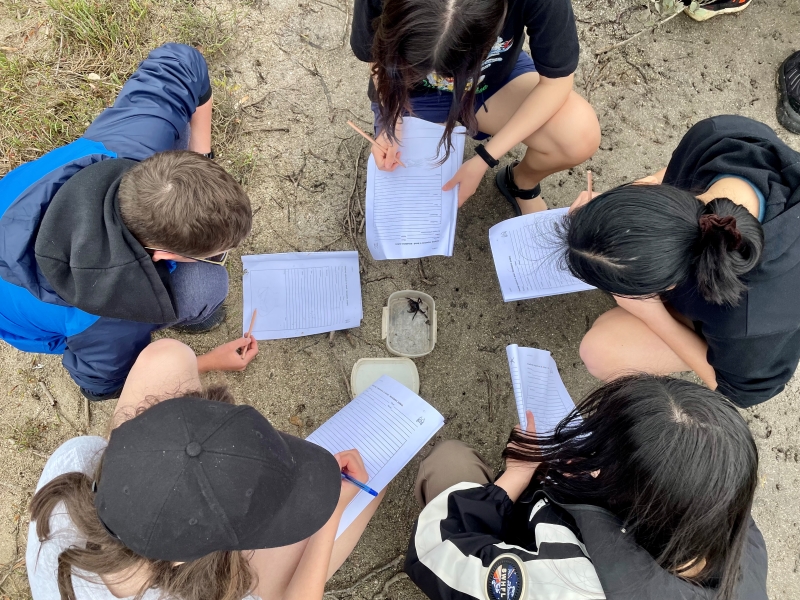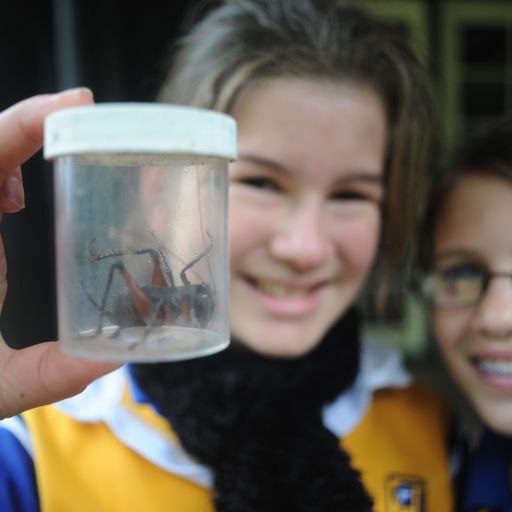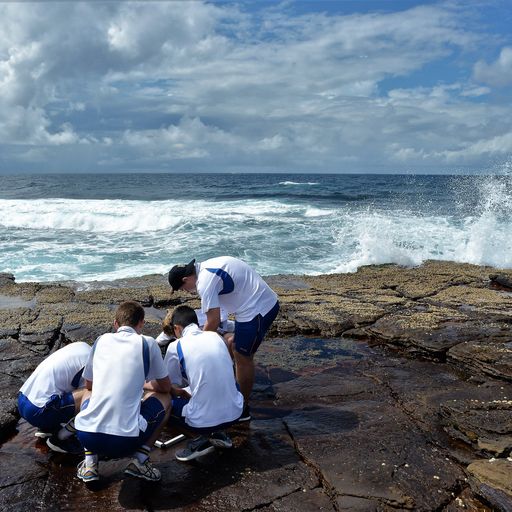Biology excursions
Auseco’s Biology field trip excursions take students to some of Sydney’s most fascinating ecosystems. Fieldwork includes primary data collection using field equipment, quadrat and transect surveys, and observing creatures, their adaptations and their roles in local ecosystem food webs.

Modules 3&4 (Year 11)
Investigate Biological Diversity and Ecosystem Dynamics in this combined program, which can also be used as stimulus or 5 hours of practical investigation towards a student’s Depth Study.
Syllabus outcomes for this field trip
BIO11/12-1 A student develops and evaluates questions and hypotheses for scientific investigation
BIO11/12-2 A student designs and evaluates investigations in order to obtain primary and secondary data and information
BIO11/12-3 A student conducts investigations to collect valid and reliable primary and secondary data and information
BIO11/12-4 A student selects and processes appropriate qualitative and quantitative data and information using a range of appropriate media
BIO11/12-5 A student analyses and evaluates primary and secondary data and information
BIO11-10 A student describes biological diversity by explaining the relationships between a range of organisms in terms of specialisation for selected habitats and evolution of species
BIO11-11 A student analyses ecosystem dynamics and the interrelationships of organisms within the ecosystem
Rock platform
Module 3: Biological Diversity
Creatures up close! Students will identify and study in detail two marine organisms – a producer and a consumer – to observe their structural features and adaptations to the selection pressures in their habitats.
Module 4: Ecosystem Dynamics
An adventurous opportunity to put fieldwork techniques into practice out on the rock platform. Students will gather abiotic data using a range of equipment, and conduct transect and quadrat surveys to determine the distribution, abundance and diversity of tidal rockshelf biota.
Locations
- Long Reef rock platform (Collaroy)
- Bass Point (Shellharbour)
Program outline
- Morning session: Site briefing, background, identify and describe a marine alga
- Midday session: Site overview from headland, abiotic testing on rock platform
- Afternoon session: Transect and quadrat surveys, animal catch on rock platform
Activities are performed in a rotation to accommodate multiple classes. The timing and location of activities will vary according to factors such as the school’s schedule, number of classes, and the environmental conditions on the day.
Sample worksheets are available which also contain details of scientific skills, equipment and secondary data provided by this program. Contact us to request.
Wetlands
Module 3: Biological Diversity
An exciting animal catch in the seagrass meadows of Botany Bay will give students the opportunity for a close encounter with marine organisms to identify, study in detail and observe their adaptations to selection pressures.
Module 4: Ecosystem Dynamics
In these hands-on activities, students will collect abiotic data in the mangrove forest and sand dunes using a variety of equipment, and conduct transect and quadrat surveys to investigate distribution, abundance and diversity of local flora and fauna.
Location
- Botany Bay (Kurnell)
Program outline
- Morning session: Site briefing, background, mangrove plant study
- Midday session: Transect on sand dune, quadrat survey in mangrove forest
- Afternoon session: Abiotic measurements, seagrass animal catch
Activities are performed in a rotation to accommodate multiple classes. The timing and location of activities will vary according to factors such as the school’s schedule, number of classes, and the environmental conditions on the day.
Sample worksheets are available which also contain details of scientific skills, equipment and secondary data provided by this program. Contact us to request.
Bushland
Module 3: Biological Diversity
Finding creatures in the creek always brings surprises! We’ll study a freshwater invertebrate to observe its adaptations to selection pressures in its habitat, and also get to know the salient features of a local eucalypt.
Module 4: Ecosystem Dynamics
The position in the landscape can have a profound impact on the dynamics of the bushland. We’ll measure and compare biotic and abiotic factors, and study particular plants that typify two different ecological niches. We’ll also carry out water quality testing to investigate human-induced ecosystemic change in the lotic food web.
Location
- Bantry Bay (Frenchs Forest)
- Camp Coutts (Waterfall)
- Camp Kedron (Ingleside)
Program outline
- Morning session: Site briefing, background, identify and describe a eucalypt tree
- Midday session: Quadrat survey of trees in two locations, biotic and abiotic testing
- Afternoon session: Water pollution testing, identify and describe a creek animal
Activities are performed in a rotation to accommodate multiple classes. The timing and location of activities will vary according to factors such as the school’s schedule, number of classes, and the environmental conditions on the day.
Sample worksheets are available which also contain details of scientific skills, equipment and secondary data provided by this program. Contact us to request.
Rainforest
Module 3: Biological Diversity
Have you ever met a squirt worm? You never know what you’ll encounter in a rainforest animal catch! We’ll study in detail a rainforest animal and a giant, stately rainforest tree to observe their structural features and adaptations to the selection pressures in their habitats.
Module 4: Ecosystem Dynamics
Students will take measurements of the biotic and abiotic conditions in the rainforest using field equipment, and analyse how these might affect population dynamics. We’ll also conduct a quadrat survey to study the abundance of tree species, examine some symbioses in action, and observe ecological succession where the rainforest has been cleared by human activities.
Location
- Mt Keira (Wollongong)
Program outline
- Morning session: Site briefing, background, quadrat survey, biotic and abiotic testing
- Midday session: Plant and leaf study
- Afternoon session: Rainforest animal catch, land clearing study
Activities are performed in a rotation to accommodate multiple classes. The timing and location of activities will vary according to factors such as the school’s schedule, number of classes, and the environmental conditions on the day.
Sample worksheets are available which also contain details of scientific skills, equipment and secondary data provided by this program. Contact us to request.

Modules 2&3 (Year 11)
Organisation of Living Things and Biological Diversity can be studied in this combined program. It will function as a stimulus or provide 5 hours of practical investigation towards a student’s Depth Study.
Syllabus outcomes for this field trip
BIO11/12-1 A student develops and evaluates questions and hypotheses for scientific investigation
BIO11/12-2 A student designs and evaluates investigations in order to obtain primary and secondary data and information
BIO11/12-3 A student conducts investigations to collect valid and reliable primary and secondary data and information
BIO11/12-4 A student selects and processes appropriate qualitative and quantitative data and information using a range of appropriate media
BIO11/12-5 A student analyses and evaluates primary and secondary data and information
BIO11-9 A student explains the structure and function of multicellular organisms and describes how the coordinated activities of cells, tissues and organs contribute to macroscopic processes in organisms
BIO11-10 A student describes biological diversity by explaining the relationships between a range of organisms in terms of specialisation for selected habitats and evolution of species
Bushland
Module 2: Organisation of Living Things
Students will discuss evolution as the driving force for biodiversity, with a study of fossil evidence and examination of stromatolite fossils.
Module 3: Biological Diversity
We’ll run a transect line to study the effect of biotic and abiotic aspects of the environment on tree species and their diversity. We’ll also enjoy a close encounter with two types of animal and two plants from the bushland ecosystem, looking at the organisation of microscopic and macroscopic structures in the organism and how they are adapted for survival.
Location
- Camp Kedron (Ingleside)
Program outline
- Morning session: Site briefing, background, fossil study
- Midday session: Transect and vegetation profile analysis
- Afternoon session: Detailed plant and animal study
Activities are performed in a rotation to accommodate multiple classes. The timing and location of activities will vary according to factors such as the school’s schedule, number of classes, and the environmental conditions on the day.
Sample worksheets are available which also contain details of scientific skills, equipment and secondary data provided by this program. Contact us to request.

Independent Research Project
Auseco can provide knowledgeable guidance and a range of field equipment to enable students to design and conduct their own practical investigation.
Bushland
This student-led field study allows individuals or small groups to conduct their own fieldwork on the rock platform as part of a Depth Study or other research project. It is suited to self-motivated, independent learners and teachers due to the level of preparation and organisation required.
- We supply a list of equipment, instructions and suggestions for investigations within the scope of the field trip.
- During their research project design phase, students research and propose an inquiry question that they will be investigating on the day, and prepare a list of equipment and survey methodology.
- Prior to the field trip, we review each student’s proposal for suitability and scope.
- On the day, our Field Guide will meet with each student to refine their planning and review the correct methods of using equipment and conducting surveys.
- In the bush, students work individually or in small groups to conduct their research.
Location
- Bantry Bay (Frenchs Forest)
Methodology
Students conduct population sampling using transect or quadrat surveys, and test abiotic factors such as tree height, soil pH, canopy cover or soil moisture. Their experimental design may test for a link between an independent variable (an abiotic factor) and a dependent variable (such as distribution, abundance or diversity) to investigate the impact of one on the other.
Examples of suitable inquiry questions could be:
- Are soil texture and moisture at different positions on the slope linked to tree height or canopy cover?
- Does the vegetation species composition vary with topography?
Rock platform
This student-led field study allows individuals or small groups to conduct their own fieldwork on the rock platform as part of a Depth Study or other research project. It is suited to self-motivated, independent learners and teachers due to the level of preparation and organisation required.
- We supply a list of equipment, instructions and suggestions for investigations within the scope of the field trip.
- During their research project design phase, students research and propose an inquiry question that they will be investigating on the day, and prepare a list of equipment and survey methodology.
- Prior to the field trip, we review each student’s proposal for suitability and scope.
- On the day, our Field Guide will meet with each student to refine their planning and review the correct methods of using equipment and conducting surveys.
- Out on the rock platform, students work individually or in small groups to conduct their research.
Location
- Long Reef rock platform (Collaroy)
- Bass Point (Shellharbour) – coming soon!
Methodology
Students conduct population sampling using transect or quadrat surveys, and test abiotic factors such as water pH, salinity, temperature or distance from wave impact. Their experimental design may test for a link between an independent variable (an abiotic factor) and a dependent variable (such as distribution, abundance or diversity) to investigate the impact of one on the other.
Examples of suitable inquiry questions could be:
- Does the size of Little Blue Periwinkles change with distance from wave action?
- How does water depth or salinity affect the diversity of species in rock pools?
- Is there a difference in the abundance of barnacles between the three tidal zones?
Wetland
This student-led field study allows individuals or small groups to conduct their own fieldwork on the rock platform as part of a Depth Study or other research project. It is suited to self-motivated, independent learners and teachers due to the level of preparation and organisation required.
- We supply a list of equipment, instructions and suggestions for investigations within the scope of the field trip.
- During their research project design phase, students research and propose an inquiry question that they will be investigating on the day, and prepare a list of equipment and survey methodology.
- Prior to the field trip, we review each student’s proposal for suitability and scope.
- On the day, our Field Guide will meet with each student to refine their planning and review the correct methods of using equipment and conducting surveys.
- In the wetlands, students work individually or in small groups to conduct their research.
Location
- Botany Bay (Kurnell)
Methodology
Students conduct population sampling using transect or quadrat surveys, and test abiotic factors such as soil texture, salinity, temperature, wind speed or canopy cover. Their experimental design may test for a link between an independent variable (an abiotic factor) and a dependent variable (such as distribution, abundance or diversity) to investigate the impact of one on the other.
Examples of suitable inquiry questions could be:
- How does the mangrove canopy influence the microclimate at Botany Bay?
- Does the abundance of oysters change between the low tide and high tide mark?
- Is there a link between species diversity and abiotic factors in the mangrove forest?
